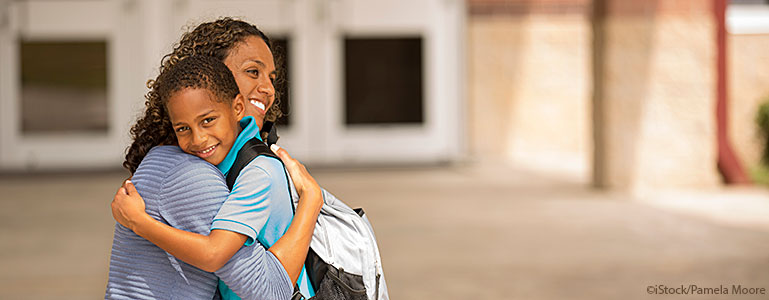Separation anxiety is one of the most painful types of anxiety because experienced, anticipated, and perceived separations are so frequent within our busy daily routines. Learn about how you can support you child with separation anxiety.
What is Separation Anxiety in Children?
From the first day of life humans are social beings. Upon a separation from a caregiver a baby rightfully senses danger and their nervous system pumps hormones, cortisol, and adrenaline through the body to activate the flight or fight response. Separation anxiety at this age of development is not just common, but expected.
While the purpose and function of anxiety is to trigger our nervous system to respond, adapt, and survive a dangerous situation, our response systems can misfire. We can cause a “false alarm” to our nervous system when we misperceive an experience or situation as dangerous when it in fact it is not.
As children grow, a babysitter or grandparent may care for the basic survival needs of a child very well when parents are away. But the child may cry, wail, and refuse to sleep until the parent returns or until they’ve exhausted themselves. This is an example of a child misperceiving the situation as a potentially dangerous and un-survivable experience. Thoughts, imaginations, and even mere anticipations can trigger the same learned fear reactions as acute, imminent danger itself.
If a child repeatedly cannot calm her separation anxiety, she then learns that not only is the distress from separation intolerable, but she also repeatedly learns that she is incapable of soothing herself. Overtime, this can affect a child’s developing self-confidence. Sadly, children with prolonged separation anxiety are at increased risk of developing patterns of insecure attachment relationships, generalized anxiety lasting into adulthood, depression, low self-confidence, substance abuse, and school drop-out.
Does My Child Have Separation Anxiety? Recognize the Signs:
- Does she often report somatic complaints — headaches, stomachaches, nausea — that aren’t medically understood and correlate with transitions and separations?
- Does he struggle to fall asleep alone or refuse to go to bed without you near?
- Does she get teary, complain, or become tense when anticipating or experiencing a goodbye?
- Does he ask to be picked up from school, miss activities, or leave sleepovers early because he prefers to be at home?
If you answered “yes” to at least two of these questions, your child may have separation anxiety.
How To Help Your Child With Separation Anxiety At School
By using basic behavioral strategies you can help your child build confidence and reduce or eliminate separation anxiety over time by following a few consistent steps:
Map out the transitions and separations experienced through your child’s day. From wake up, school drop-off, classroom transitions, school pick-up, after-school activities, to bedtime. You may even devise a visual schedule to assist your child with anticipating these transitions. If your child has a parent or caregiver that travels or frequently works late, these transitions and separations should also be considered.
Set a consistent transition routine with your child and use it at every goodbye. Your farewell routine may include a particular phrase such as, “I love you, see you soon.” It may also include a special handshake or high-five or one hug and two cheek kisses. Your child may benefit from a transition object such as a favorite stuffed animal or a handwritten note for comfort. It is best if the transition routine is as clear and predictable as possible.
Sit down with your child and devise a plan together to slowly guide your child through mastering planned separations. This is essentially a gradual exposure to your child’s fears. Remember, a child with separation anxiety is most terrified of being left, abandoned, out of control, and unable to survive. You may begin by allowing them some control during transitions and separations. For example, plan a school drop-off with your child leaving you to join an activity rather than your child watching you leave them in the classroom.
Positively praise and reinforce your child’s successful ability and growing capacity to tolerate small doses of distress from separation. Make sure you let them know that you believe in them! Gradually, you will increase the length of time of separations and decrease the length of transitions using transition supports. With consistency, kindness, and positive support most parents successfully help their child move through their fears of separation.
Professional Help For Your Child’s Separation Anxiety
If you have already tried many of these suggestions and you are still finding that your child is experiencing anxiety, consider reaching out for additional support and guidance with devising and implementing an individualized plan for your child.
The Center for Children and Youth’s experienced team of clinical social workers, marriage and family therapists, psychologists, and psychiatrists, as well our parent coaches, can help you and your children manage anxiety. Learn more about our wide range of services. Or, call 888-927-0839 for more information.
SCHEDULE YOUR PARENT CONSULTATION
Ellie Pelc, PsyD, Associate Clinical Director of CCY.



